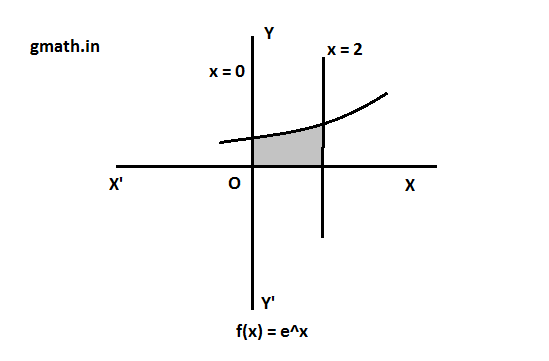Question 2:- Let f : R → R be a twice differentiable function such that f(x + y) = f(x) f(y) for all x, y ∈ R. If f'(0) = 4a and f satisfies f”(x) – 3a f'(x) – f(x) = 0, a > 0, then the area of the region
R = {(x, y) | 0 ≤ y ≤ f(ax), 0 ≤ x ≤ 2} is :
(i) ![]() (ii)
(ii) ![]()
(iii) ![]() (iv)
(iv) ![]() [JEE 22 JAN 2025]
[JEE 22 JAN 2025]
Answer :- (i) ![]()
Explanation:- Let f : R → R be a twice differentiable function such that
f(x + y) = f(x) f(y)
Let the function, f(x) = ![]() . . . (i)
. . . (i)
Now, ![]()
Given, f'(0) = 4a
![]()
⇒ 4a = k
Substituting in equation (i)
So, ![]()
Since, ![]()
![]()
Given,
f”(x) – 3a f'(x) – f(x) = 0
![]()
Since, ![]()
So,
16 a² – 12 a² – 1 = 0
⇒ 4a² = 1
⇒ a = 1/2, a > 0
![]()
⇒ ![]()

Area of shaded region ![]()
![]()
![]()
![]()
![]()
Question 1:- The number of non-empty equivalence relations on the set {1, 2, 3} is :
(i) 6 (ii) 7
(iii) 5 (iv) 4 [JEE 22 JAN 2025]
Solution :- See full solution
Question 3:- Let the triangle PQR be the image of the triangle with vertices (1, 3), (3, 1) and (2, 4) in the line x + 2y = 2. If the centroid of ΔPQR is the point (α, β), then 15(α – β) is equal to :
(1) 24 (2) 19
(3) 21 (4) 22 [JEE 22 JAN 2025]
Answer:- See full answer
Question 4:- Let ![]() and
and ![]() be three complex numbers on the circle |Z| = 1 with
be three complex numbers on the circle |Z| = 1 with ![]() and
and ![]() . If
. If ![]() , then the value of α² + β² is :
, then the value of α² + β² is :
(1) 24 (2) 41
(3) 31 (4) 29 [JEE 22 JAN 2025]
Answer : See full Answer
Question 5:- Using the principal values of the inverse trigonometric functions the sum of the maximum and the minimum values of ![]() is :
is :
(1) 24 π² (2) 18 π²
(3) 31 π² (4) 22 π² [JEE 22 JAN 2025]
Answer :- See full answer
Question 6:- A coin is tossed three times. Let X denote the number of times a tail follows a head. If μ and σ² denote the mean and variance of X, then the value of 64(μ + σ²) is :
(i) 51 (ii) 48
(iii) 32 (iv) 64 [JEE 22 JAN 2025]
Answer:- See full solution
Question 7:- Let ![]() be a G.P. of increasing positive terms. If
be a G.P. of increasing positive terms. If ![]() and
and ![]() , the
, the ![]() is equal to
is equal to
(i) 628 (ii) 526
(iii) 784 (iv) 812 [JEE 22 JAN 2025]
Answer:- See full Answer
Question 8:- Let ![]() and
and ![]() be two lines. Then which of the following points lies on the line of the shortest distance between
be two lines. Then which of the following points lies on the line of the shortest distance between ![]() and
and ![]() ?
?
(i) (-5/3, -7, 1) (ii) (2, 3, 1/3)
(iii) (8/3, -1, 1/3) (iv) (14/3, -3, 22/3) [JEE 22 JAN 2025]
Answer:- See full solution
Question 9:- The product of all solutions of the equation ![]() is :
is :
(i) ![]() (ii)
(ii) ![]()
(iii) ![]() (iv)
(iv) ![]() [JEE 22 JAN 2025]
[JEE 22 JAN 2025]
Answer :- See full solution
Question 10:- If ![]() , then
, then ![]() is equal to
is equal to
(i) 1 (ii) 0
(iii) 2/3 (iv) 1/3 [JEE 22 JAN 2025]
Answer :- See full Answer